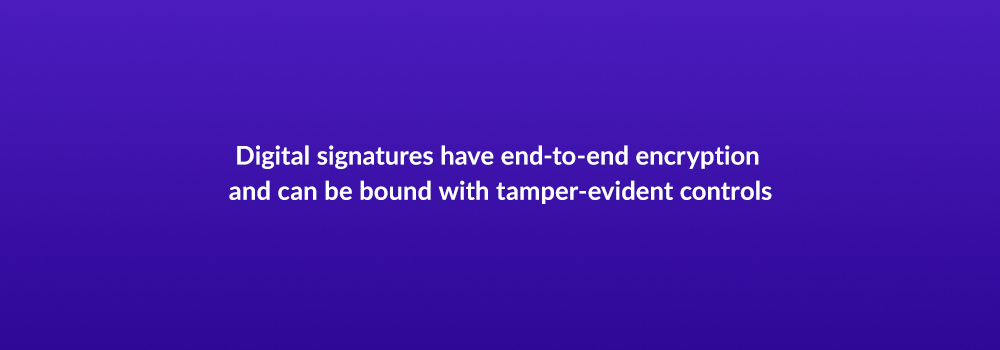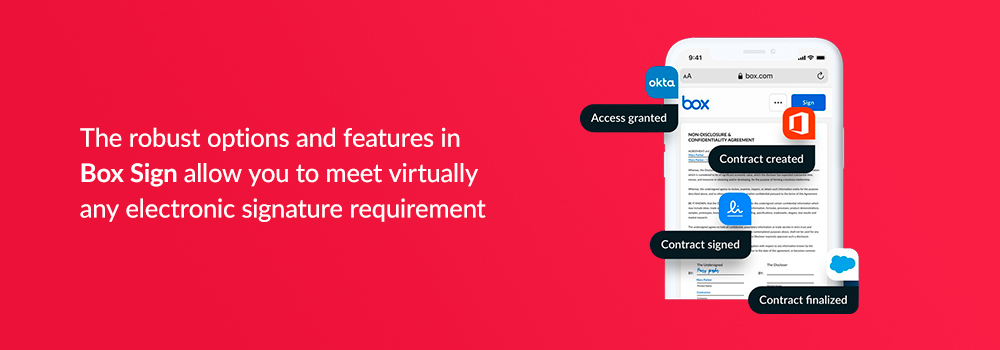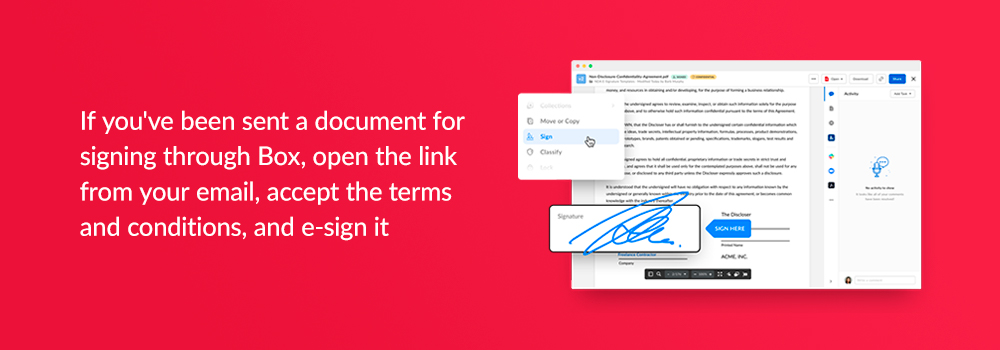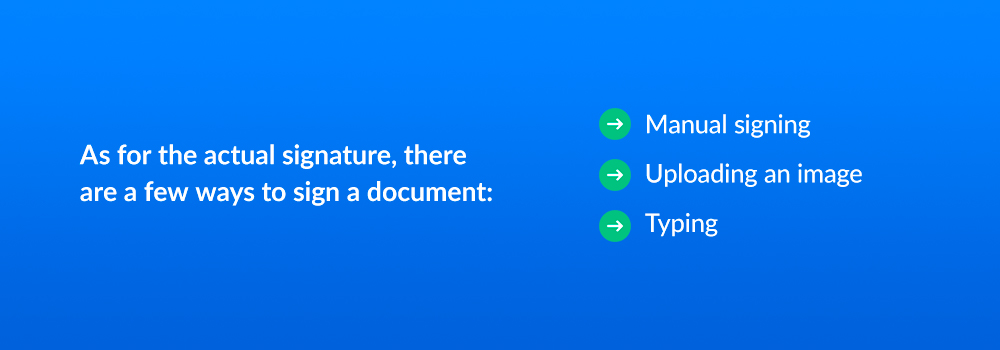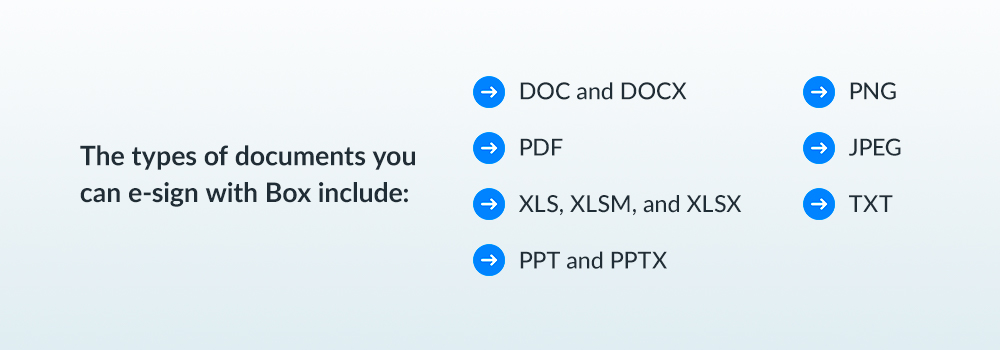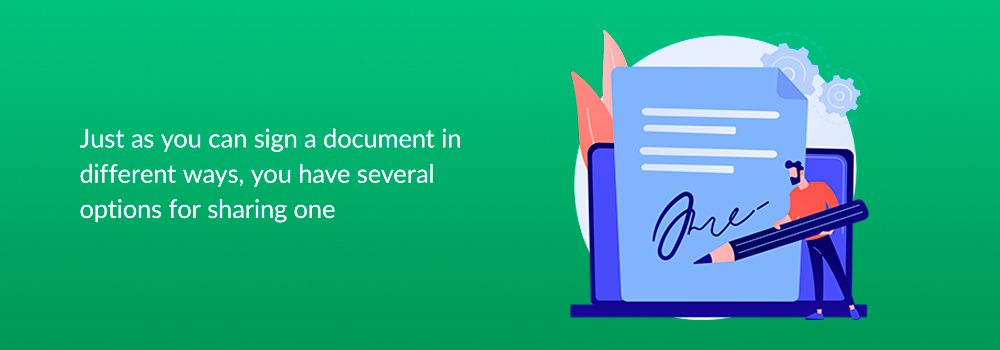How to create an electronic signature
These days, it’s fairly common to complete an entire contract or make a sale without ever seeing your client in person. One of the only snags in the process comes up when legal signatures are needed.
E-signatures solve this challenge, but only a third of companies currently take advantage of e-signature capabilities. Instead, they expect clients and coworkers to take on the time-consuming process of printing and scanning documents in order to sign them.
Maybe they’re concerned about learning a new technology. Possibly they just haven’t gotten around to it yet. Either way, they’re losing out on a valuable opportunity to make document signing efficient, digital, and secure.
The reality is, e-signing digital documents is easier and far faster than printing, signing, scanning, copying, and sending paper documents. It’s also more secure. Electronic signatures are an excellent way to make business processes more efficient and set yourself apart from the competition. They can add security, convenience, and other benefits to the workday and your organization as a whole, especially when they’re part of a cloud content management (CCM) system.
In this article, you’ll find out how to create an electronic signature, how to keep your signatures secure, and how to blend e-sign into your content lifecycle.
Are electronic signatures secure?
In many cases, e-signatures are even more secure than paper signatures. Digital signatures have end-to-end encryption and can be bound with tamper-evident controls. They're appropriate for even the strictest of authentication requirements and are legally authorized to replace handwritten signatures in virtually any business or personal application. In addition, a verified, secure e-signature provider should offer bank-level security to protect data throughout its lifecycle.
Bank-level security means you can achieve compliance across various standards and guidelines, including:
- The Health Insurance Portability and Accountability Act (HIPAA)
- System and Organization Controls (SOC)
- The International Organization for Standardization (ISO)
- The Federal Risk and Authorization Management Program (FedRAMP)
- The Department of Defense Impact Levels (DoDIL)
- International Traffic in Arms Regulations (ITAR)
These standards include some of the strictest in the industry and allow e-signatures to be used in tightly regulated sectors like finance and healthcare. A trusted electronic signature service should employ enterprise-grade data centers with 24/7 monitoring and regular updates. These facilities will continuously monitor servers with teams of data security experts on hand. Their whole business is security, so these companies usually offer protection superior to an in-house team. Plus, without physical documents, there's less room for theft, defacing, or unauthorized access.
Similarly, high-end technical standards and controls, such as AES 256-bit encryption and SAS 70 Type II certification, are essential. You can add even greater security to a document through two-factor authentication (2FA). This process requires the signer to confirm their identity before signing a document. Box, for example, verifies identity via text messages or passwords provided by the sender. The signer can't access the document until they complete this process.
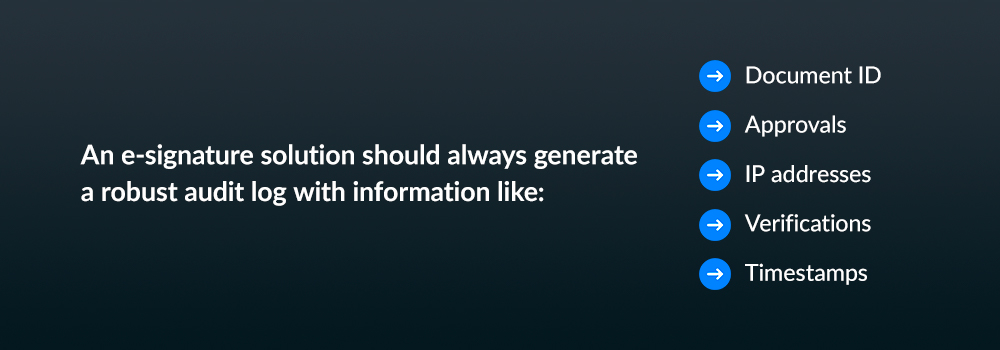
Document integrity is another key part of security and compliance. An e-signature solution should always generate a robust audit log with information like:
- Document ID
- Approvals
- IP addresses
- Verifications
- Timestamps
Audits should be valuable for internal dealings and problem-solving, as well as showing proof of compliance for regulatory agencies. Should someone investigate your company, audit logs provide comprehensive proof of all activity related to that document.
Digital certificates are another way to support document integrity. They add tamper-evident seals to the file. These show up as a green checkmark in supported PDF readers and are issued by trust service providers (TSPs). They authenticate both parties' identities and bind the proof to the document.
These certificates, AKA public key certificates, use cryptography to ensure a more reliable encryption method. Essentially, digital certificates constitute a carefully guarded assurance that the sender is who they say they are. The sender's identity is confirmed by a trusted certificate authority and linked up to the key that gets sent within the document's metadata. This chain of trust is very hard to break.
With these kinds of protection measures, you get peace of mind knowing the sensitive data of your company and your clients is well-protected. From patient forms and sales records to top-secret military proceedings, e-signatures offer extensive security without sacrificing convenience.
Are electronic signatures legal?
Electronic or digital signatures are typically just as binding as written ones. In the United States, this was determined back in 1999 and 2000, when the Electronic Signatures in Global and National Commerce (ESIGN) Act and the Uniform Electronic Transactions Act (UETA) were signed. These acts provided a general rule of validity for electronic signing, as long as the consumer has given consent and hasn't withdrawn it.
In the European Union, there's regulation on electronic identification and trust services (eIDAS). Most developed countries have similar legislation in place. There may be some requirements, such as verifying the signer's identity and creating audit trails. Still, electronic signatures can generally be used across borders without much hassle, especially when your signing platform has the necessary tools and securities built in.
Other important components of a digital signature include intent and final proof.
- Intent includes methods that prove the signer fully intended to sign the document electronically. Proving intent can be as simple as completing a manual signing process or clicking a checkbox accepting the agreement.
- Final proof adds evidence and strengthens record keeping by sending copies to those who need them and collecting audit details.
Electronic signatures can even help you improve compliance through stronger record keeping. Paper documents are subject to defacing, theft, and loss. Electronic documents can be securely stored on your business servers, minimizing the chances of loss or destruction. Organized document storage also makes it easy to find what you're looking for and meet retention requirements.
In short, electronic signatures are legal, but the specifics may vary from location to location. The robust options and features in Box Sign allow you to meet virtually any electronic signature requirement.
How do I create an electronic signature on a document?
It’s possible to create electronic signatures in a few different ways, and if you’re already using Box, you can both sign and request e-signatures without leaving the context of your content.. With Box Sign, creating an e-signature request is as easy as adding signature fields, designating who's signing, and sharing or saving the document. You can then request an e-signature from just about anyone with an email address, regardless of whether or not they are a Box user.
Box allows you to include fields for the signature itself, the date of signing, a checkbox, and a text field. You can place these fields anywhere on the document.
Other Box Sign options include:
- Designation of required fields: Mark any fields that are mandatory
- Pre-filled dates: Have the document autofill the date on which the signer accesses the file
- Sending and receiving data from other applications: With external IDs, you can both pull from and send data to other applications like Excel — for example, to include a birth date typed in a text field
- Expiration dates: Set up a designated day when the signature request will no longer be valid
- Notification messages: Include a custom message your recipients will see when the document is emailed to them
- Auto reminders: Send reminders to signers if they don't complete the request after a certain period
- Security options: Add a password or authentication measure to confirm your signer's identity
- Signature order: If multiple people are signing, you have the option to designate the order in which they sign
- Multiple fields: If you need signatures throughout a document, you can add multiple fields for the same signer
The prompts in Box Sign walk you through this process, but below are some of the basic methods for creating an e-signature with Box Sign.
1. Upload a document to sign yourself
If you already have a paper or electronic document that needs signing, you can scan or upload it — which is easy with Box. Simply drag and drop your file into Box (or scan it in over our mobile app), open the file, select yourself as the person signing, sign it, and choose where you want to save the request. You can also add any fields not present in the original document, like checkboxes and explanatory text.
This is a quick, simple method for signing documents that call for just your signature and won't need to be sent to someone else for approval or review. You can immediately save the document wherever you need to.
2. Send a document for you and/or someone else to sign
Just about anyone else can e-sign a document, whether they're inside or outside your organization, and regardless of whether they have a Box account. Generating these requests is similar to signing a document yourself, except you'll select "Me and others" or "Only others." You can then add the recipients, including people who need to approve the document or simply receive a signed copy of it. Complete this step by assigning roles to your recipients when you add them.
3. Sign a document that was sent to you
If you've been sent a document to sign through Box, open the link from your email, accept the terms and conditions, and e-sign it. Click "Sign & Finish," and you're done. We'll go over the ways you can sign in the next section, but know that you can apply a signature from any device — great for sending a quick signature during your coffee run. You can also add a signature to multiple locations in the document or reassign the signing role to someone else.
However you choose to do it, adding electronic signatures is a quick process, especially when you can do everything from one secure place. Many features are available to make the process smoother and more efficient for businesses, such as bulk sending, templates, and signer authentication.
How to sign documents with an electronic signature
As for the actual signature, there are a few ways to sign a document.
- Manual signing: On any device, using your finger, mouse, or a stylus, draw your signature Uploading an image: Save an image of your signature for an easy one-click upload
- Typing: Simply type in your name and apply a font that resembles handwriting
All options are equally valid, so the choice comes down to personal preference. Signing with a stylus provides the most authentic option, but you have to do it every time. A quick image upload allows you to perfect your signature and reuse it. Typing is neat and easy but not quite as personalized as the other two methods. Consider your typical workflow and the devices you use. You can always change up your signature style for a particular document based on what you feel like doing that day and the nature of the document.
You'll likely need to fill out additional fields, too, such as a checkbox to confirm terms and conditions and the date. You can sign documents on just about any device that can access the internet. Box integrations and application programming interfaces (APIs) even allow you to sign and send requests from within your website, custom applications, and popular platforms like Salesforce and Microsoft 365.
Which document formats can I e-sign?
With the right e-sign platform, you can add this capability to most document, presentation, and text-based files, as well as some image files. The types of documents you can e-sign with Box include:
- DOC and DOCX
- XLS, XLSM, and XLSX
- PPT and PPTX
- PNG
- JPEG
- TXT
For a full list of documents supported on Box, check out our support page.
When you have support for a wide variety of documents, you ensure greater flexibility for your business and clients. You can use the right file type for your projects, ensuring it meets everyone's needs and puts the best face forward for your clients. If you already use Box, you'll see e-sign options right from within the app on supported documents.
Complete your signed document
The job is rarely finished after the document is signed. From there, you may still have a range of tasks ahead, like saving it to the cloud, gathering more signatures, having someone approve the final file, or sharing it with others. These can be complicated tasks, requiring multiple, disconnected versions and emails back and forth — or they can be as simple as clicking a button. It depends what e-signature platform you use.
Below are some tasks you may need to consider after sending off your document. All of them should occur seamlessly. An integrated platform can help you avoid data silos, duplicate downloads, slow responses, and other problems that come from disconnected processes. This approach makes the most of your e-signing solution and can extend its benefits to more areas of business.
1. Saving your documents
You could worry about having multiple documents on every signee's device or lugging around a hard drive — or you could save them in one spot in the cloud. Storing your documents directly in the Content Cloud saves time, improves security, and creates centralized visibility for everyone who needs access. Updates occur in real time, and everyone stays on the same page.
2. Monitoring document status
If you've sent a document via email and are waiting for a scanned image to come back, there's not much you can do to monitor the document. The Content Cloud allows you to check in whenever you like. You can even monitor the request status to see who's viewed, signed, canceled, or declined the document. Turning on notifications sends those updates directly to your email.
The Content Cloud also makes it possible to check in on your contract from anywhere. Whether you're making an on-site visit to a client or enjoying a lunch break, you can “pop up” and see how things are progressing.
3. Sending reminders
Do your signees need a little nudge? Implement automatic email reminders at a specified interval or manually send one.
4. Taking the next step in the workflow
E-signatures tie into Box workflow tools with serial and parallel document routing. You can easily automate processes like sending a contract for approval.
Handling signed documents is quick and easy when you integrate your e-signing platform with the Content Cloud. Box has over 1,500 connected apps and developer tools for extensive customization. From authorizing users through Okta to finalizing contracts in Salesforce, you can utilize built-in e-signatures securely and flexibly. Your business clients also appreciate signing documents with familiar tools. Create a more efficient workflow and extend the value that e-signatures have for your business.
How to share your electronic signature document
A signed document generally needs to be sent somewhere — that may look like saving a simple record to a CMS folder or the cloud, or sending it to multiple recipients for review, approval, and more signatures. Just as you can sign a document in different ways, you have several options for sharing one.
For documents shared with coworkers, the easiest approach is to save the file directly into the cloud and make sure your colleagues are added as collaborators. In Box, you simply click the share button and add their names or emails. Or you can add them as recipients before sending out the signature request. They'll receive notifications when signatures are added, and you can add up to 35 recipients.
To share a document with a client or someone outside of your e-signature platform, you'll need to start a new request and follow the instructions for adding your file and identifying recipients. Box uses a role-based system for recipients where you can designate whether they're signing, getting a copy, or approving the document. You can also mark the document for in-person signatures, specify signing order, and add security requirements like 2FA or passwords.
If you're working within a third-party platform through Box integrations, these steps might look different.
Many businesses use the same contracts with multiple clients and partners. Templates are a great way to speed up the process. By saving a template to your Box account, you can skip most of the document generation steps and go straight to sharing. Similarly, bulk sharing options allow you to send individual requests to multiple recipients. While great for efficiency, these sharing features can also help standardize documents and minimize errors.
**While we maintain our steadfast commitment to offering products and services with best-in-class privacy, security, and compliance, the information provided in this blog post is not intended to constitute legal advice. We strongly encourage prospective and current customers to perform their own due diligence when assessing compliance with applicable laws.
